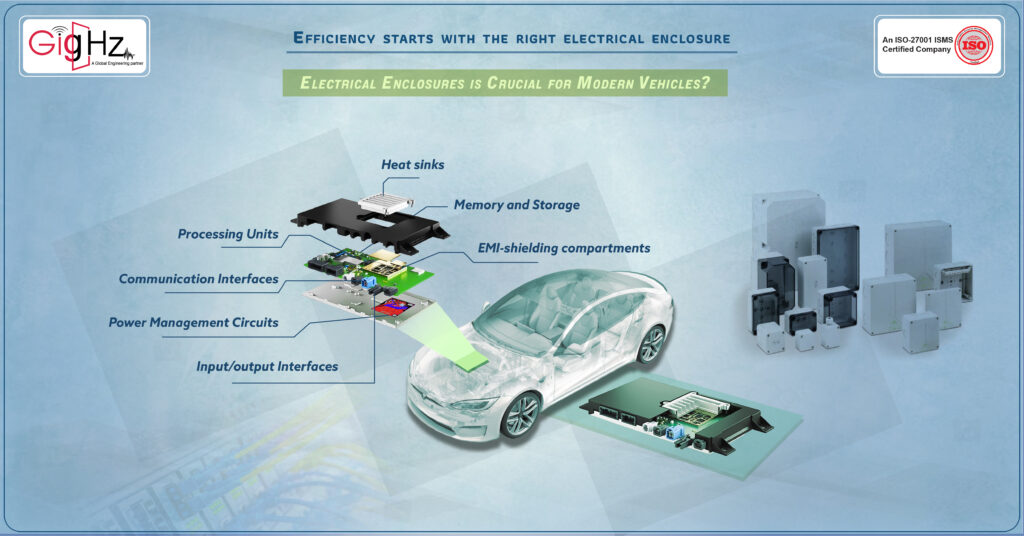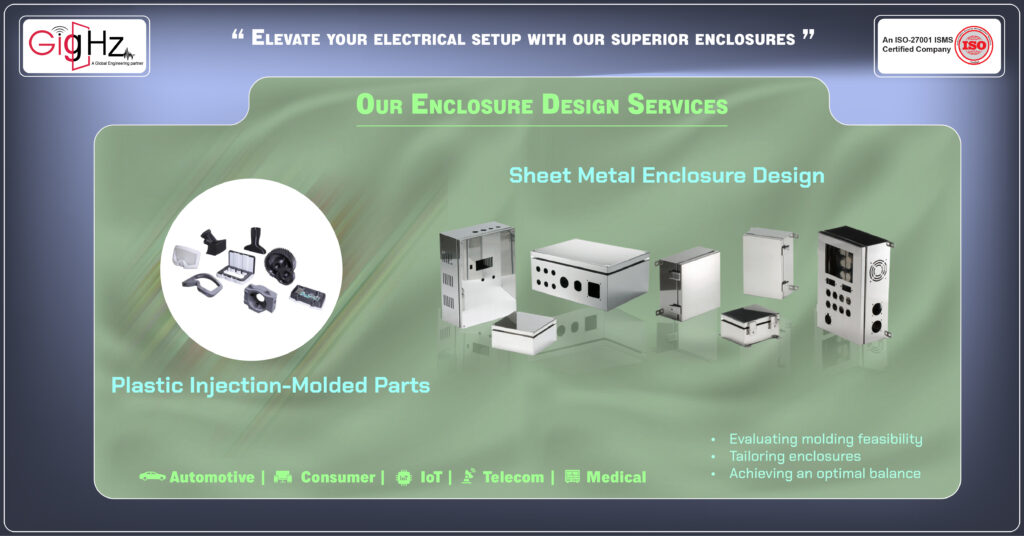Why Proper Design of Electrical Enclosures is Crucial for Modern Vehicles?
- Posted On:
- September 18, 2024
- Category:
- Mcad

Electrical enclosures
In today’s advanced vehicles,
Electrical enclosures play a critical role in safeguarding the complex electronics that drive everything from engine performance to infotainment systems.
Think of it this way,
Modern cars are essentially computers on wheels, packed with sensitive electronic components like Telematics Control Units (TCUs), engine control modules, and more.
These components need protection from harsh conditions—whether it’s extreme heat, moisture, or dust—and that’s where electrical enclosures come into play.
But it’s not just about keeping the environment out.
These enclosures also shield the electronics from electromagnetic interference (EMI) that can come from other systems in the vehicle.
Without proper protection, you could see performance issues, malfunctions, or even complete system failures, which is something no one wants, especially when it comes to safety-critical systems.
And speaking of safety, well-designed enclosures are key to preventing electrical shorts and protecting against power surges.
They ensure that in the event of a collision or impact, the systems inside remain secure and operational.
In short, the design of these enclosures isn’t just about housing components—it’s about ensuring the reliability, safety, and performance of the entire vehicle.
That’s why getting the design right is so crucial.
Why the Electrical Enclosure matters?

Firstly, electrical enclosures provide protection from environmental factors. They shield sensitive electronic components from extreme temperatures, moisture, and dust. In a vehicle, enclosures safeguard important systems like the Telematics Control Unit (TCU) from rain, heat, and other harsh conditions, ensuring these components continue to function correctly regardless of the weather.
Safety is another crucial aspect of electrical enclosures. They help prevent accidental contact with live electrical parts, reducing the risk of electric shocks. Additionally, enclosures are designed to contain any sparks or flames that might occur due to electrical faults, thereby protecting both people and the vehicle from potential hazards.
Enclosures also play a vital role in blocking electromagnetic interference (EMI). Modern vehicles are equipped with various electronic systems that must operate harmoniously without interference. Enclosures help mitigate EMI from other vehicle components, ensuring systems such as navigation and communication work seamlessly without disruptions.
Furthermore, electrical enclosures protect against physical damage. In a vehicle, where components are subjected to constant movement, impacts, and vibrations, enclosures help secure these parts and prevent damage. They also act as a deterrent against tampering, making it more difficult for unauthorized individuals to access or damage sensitive systems.
Lastly, enclosures contribute to the overall reliability of electronic components. By maintaining a stable internal environment, they help extend the lifespan of these components and facilitate easier maintenance and repairs, which is crucial for the long-term reliability of the vehicle’s electronic systems.
Why Proper Design of Electrical Enclosures is Crucial for Modern Vehicles?

When designing an electrical enclosure for a Telematics Control Unit (TCU), it’s crucial to address the specific requirements of each component within the TCU.
Here’s how to design the enclosure effectively to meet these needs:
1. Communication Interfaces
- Cellular Modems: Enable mobile network connectivity for real-time updates and remote diagnostics.
- Bluetooth/Wi-Fi Modules: Facilitate short-range communication with external devices.
- CAN Bus Interfaces: Manage communication between the TCU and other vehicle systems.
Design Considerations:
Ensure the enclosure minimizes signal attenuation and interference. Use materials that provide good electromagnetic shielding, such as conductive coatings or dedicated EMI shielding layers. Design the enclosure to prevent signal disruption by incorporating shielding compartments or barriers.
Plan for optimal antenna placement and orientation within the enclosure. Include provisions such as mounting brackets and slots to secure antennas in positions that ensure clear signal paths. Ensure that antennas are not obstructed by other components or enclosure materials.
2. Processing Units
Central Microcontrollers/Processors: Handle data management, execute control algorithms, and interface with other vehicle systems.
Design Considerations
Integrate heat dissipation features such as heat sinks, thermal pads, or active cooling systems (e.g., fans) within the enclosure. Ensure that the design allows for adequate airflow and heat dissipation to prevent overheating.
Design the enclosure with proper ventilation openings or cooling channels to promote airflow around the processing units. Use perforated panels or mesh covers to enhance air circulation while protecting against dust ingress.
3. Power Management Circuits
- Voltage Regulators: Ensure stable power supply to the TCU’s components.
- Power Distribution: Distribute power across different sections of the TCU.
Design Considerations
Implement EMI shielding within the enclosure to protect power management circuits from external electromagnetic interference. Use shielded cables and connectors where necessary.
Design the enclosure with features to manage heat generated by power management circuits. Incorporate heat sinks or thermal vias to transfer heat away from sensitive components.
4. Input/output Interfaces
Connectors and Ports: Facilitate communication with sensors and external devices for diagnostics and system integration.
Design Considerations
- Accessibility and Protection: Ensure that connectors and ports are easily accessible while being protected from environmental factors such as dust and moisture. Use gaskets, seals, or covers to provide environmental protection. Design the enclosure with adequate space around connectors to allow for easy connections and disconnections.
- Signal Integrity: Shield the areas around connectors and ports to prevent signal interference. Design the layout to minimize signal degradation by avoiding sharp bends or long runs of signal traces.
5. Memory and Storage
Flash Memory: Stores firmware, software, and operational data.
Design Considerations
- Thermal Management: Include thermal management features in the enclosure to maintain proper operating temperatures for memory components. Use heat spreaders or thermal pads to dissipate heat effectively.
- Vibration Isolation: Protect memory components from mechanical vibrations by incorporating vibration-resistant mounts or isolation pads within the enclosure. Ensure that memory modules are securely mounted to prevent movement and potential damage.
Our Enclosure Design Services

GigHz specializes in customized plastic injection-molded parts and offers tailored indoor and outdoor electronic enclosure design services. We cater to diverse sectors, including automotive electronics, consumer electronics, IoT, telecom, and medical products.
Our Services Include:
- Evaluating molding feasibility during the design phase.
- Tailoring enclosures to meet specific customer requirements.
- Achieving an optimal balance between mass and rigidity.
Sheet Metal Enclosure Design
Our expertise in sheet metal enclosure design transforms flat sheets into functional and stylish 3D structures, providing excellent protection for your electronic devices.
Our Services Include:
- Collaborating with metal fabricators and manufacturers throughout the design process.
- Designing efficient cooling solutions to enhance electronic component performance.
- Crafting precise EMI shields to match component tolerances and protect circuit elements.
Final Thoughts
When choosing the right electrical enclosures for various applications, it’s important to consider the level of protection they provide against electrical hazards.
NEMA ratings, such as NEMA 1, NEMA 12, and NEMA 4X, indicate the suitability of materials like steel, aluminum, and plastic for indoor and outdoor applications.
Enclosures are designed to protect electrical components and electronic equipment from environmental conditions, ensuring durability and resistance to corrosion. For hazardous locations, hazardous location enclosures provide a cost-effective solution to manage and distribute power safely.
Manufacturers must engineer junction boxes and cabinet enclosures that can withstand various hazardous conditions while maintaining flexibility for automation and utility wiring.
Industrial applications often require wall-mount enclosures that offer enhanced protection against explosion risks. The expertise in selecting rated enclosures, along with adherence to IEC regulations, ensures that the equipment remains functional and safe in any environment.
“Ready to turn your ideas into reality?
Need tailored solutions? Discover how our services can meet your needs today! https://gighz.net/services/
Design Beyond Boundaries—Get in Touch for Top-Tier MCAD Solutions! https://calendly.com/gighz/30min
Table of Contents
Latest Post
Get Customized Engineering CAD Design Service

Book a Free Consultation Call
Partner with Gighz and bring your most innovative design concepts to life. Our engineering cad services accelerate development so you can focus on your big vision.
